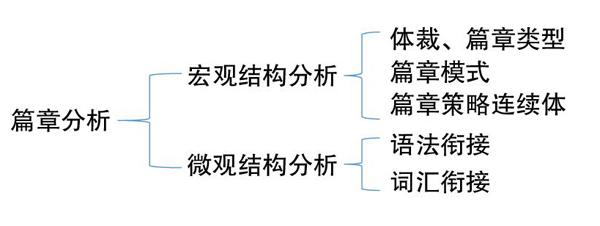语篇分析在高中英语阅读课教学设计中的应用案例
2021-10-11聂桂花


篇章分析(discourse analysis)包括宏观结构分析和微观结构分析。宏观结构分析主要是体裁(genre),篇章类型( text type),篇章模式( textual pattern),篇章策略连续体( text - strategic continuity)。微观结构分析则是语法衔接(grammatical coherence)和词汇衔接(lexical cohesion)
本文以人教版高一英语M1U3 Travel Journey 为例,阐释语篇分析在高中英语阅读课教学设计中的应用。本课的教学模式给出的例子来自高考阅读、跨学科等材料,启发学生发现规律,总结并传授相关语篇分析基本知识,然后运用到本课的阅读篇章分析中。
首先,本节课共设计为五个部分:第一部分,体裁、篇章类型(语体风格);第二部分篇章策略连续体;第三部分,人物品质描写、段落组成、语义场、词汇衔接;第四部分,语法衔接;第五部分,运用。
本课教学目的:Students will be able to.
1. Learn the basic knowledge about discourse analysis(了解语篇分析的基本知识)。
2. Figure out the genre, textual pattern, text-strategic continuity of the text(弄清楚文章体裁,篇章策略连续体)。
3. Analyze the structure of each paragraph(分析每段的结构)。
4. Grasp some skills of cohesion and coherence of discourse(掌握语篇的形连和意连)。
第一部分,体裁、篇章类型(语体风格):以图片的形式展示导入部分 My trip in Switzerland,然后匯集成文如下。
This summer vacation...During the first several days, ...a famous attraction ... beautiful...In the next few days, ...small ...grand ...At last, ... most popular tourist destinations ....slow, relaxing and romantic ...
通过下划线和框出的线索词引导学生说出文体Narrative(叙述),Descriptive(描写)。
接着进入阅读部分讲解文章体裁的类型(语篇分析基础知识一)expository(说明类),descriptive(描写类),narrative(叙述类),argumentative(论辩类),persuasive(说理类),instructive(指导类)。
第二部分篇章策略连续体。以How does the writer bring out the theme——the dream and the plan in the first paragraph? 为问题,指导学生Find out the lexical chains to help you。
以How does the writer develop the text?为启发问题,导出语篇分析基础知识二:篇章策略连续体。包括:时间连续体(continuity of time),人物连续体(continuity of participants),主题连续体,(continuity of topics)空间连续体(continuity of space),行为连续体(continuity of action)。
然后以高考试题为例展示语篇分析是如何在高考阅读题中考查的。...In his late teens, ... At that time, ... soon ... 61. The third paragraph is developed __C__.
A. by space B. by examples
C. by time D. by comparison
回到课文,模仿高考题设置课文阅读问题。Task 3: The first paragraph is developed __C___.
A. by space B. by examples
C. by time D. by comparison
把高考阅读和平时的课文阅读结合起来在语篇分析的理念下进行解读与理解,让学生在更高的角度来理解课文。
第三部分:人物品质描写、语义场、词汇衔接、段落组成。语篇分析基础知识三Quality+ supporting details。
给学生举例子,如:
1. Wayne is very shy. For example, he finds it difficult to make new friends.
2. He speaks in a soft voice as if he were whispering.(referring to the way they speak)
3. She constantly uses her hands when she speaks.(describing the gestures they use)
4. Jason always bites his nails when he is nervous.(mentioning a particular habit they have.)
以表格的形式找到课文有关人物性格描写的词,和支持要点。
语篇分析基础知识四:语义场——同一话题场景词汇:情绪、态度、观点。包括positive(正面)和 negative(负面)。要求学生进行讨论:Try to find out my attitude towards her. Stubborn, but I am fond of her. Find the clue.引导学生进行语义场词汇链分析。
Pa2: ... one serious shortcoming. ... stubborn. ...determined ... would not change her mind. ... made up her mind, nothing can change it. ...(过渡句,我的态度)
语义场——突出主题意义。
段落组成:总(general)-分(specific)-总(general)
Topic sentence——Qualities and supporting justification——Finally, I had to give in.
第四部分:语法衔接,连贯。语篇分析基础知识五:衔接包括语法衔接,词汇衔接和篇章策略。
语法衔接手段包括:指称:人稱指称,指示指称,比较指称等;替代;省略 ;连接:增补型(Additive),转折型(adversative),因果型(causal),时间型(temporal)、并列、列举、条件、让步等。词汇衔接(lexical cohesion)手段包括:1.重现:(1)原词重复(Repetition);(2)同义、近义词关联(synonym or near-synonym);(3)上下义关系(hyponymy),上义词:总——概括,下义词:分-被包含同现。2.固定搭配(collocation),3.语义场(同一话题场景词汇)——形成词汇链(lexical chain)。
然后转回到阅读课文,进行衔接分析。包括语法衔接,词汇衔接和篇章策略。
Several months before our trip, Wang Wei and I went to the library. In the library(填入省略的词) , we found a large atlas with good maps that showed details of world geography.
1. From the atlas ... River begins in a glacier ...
1. 起源
2. ... the water is clear and cold.
2. 水质
3. ....move quickly.
3. 流速
4. ...it passes through deep valleys, traveling across ...
4.途经地区——路径
5. ... a water fall and enters wide valleys. We ...learn that half of ...
5.承上启下:过渡句
6. After it leaves ...the Mekong becomes wide, brown and warm.
6.离境后水质的变化
7. It makes wide bends or meanders through low valleys...
7.离境后流速、路径的变化
8. At last, the river delta enters ...
8. 最终流入南中国海
第五部分总结给学生:句子链接主要是代词和连词。最后起到形连和意连的目的。
第六部分:总结。
最后引导学生进行总结。
以上就是语篇分析在高中英语阅读课教学设计中的一个应用案例。这只是一节课的应用,不能解析所有的语篇分析知识。希望有感兴趣的老师能在阅读教学中运用语篇分析知识来提高我们的阅读教学能力。
参考文献:
[1]胡壮麟.新编语篇的衔接与连贯[M].上海:华东师范大学出版社, 2018.
[2]教育部.普通高中英语课程标准(2017年版2020年修订)[S].北京:人民教育出版社,2020.
【作者简介】聂桂花,广东实验中学附属天河学校。
